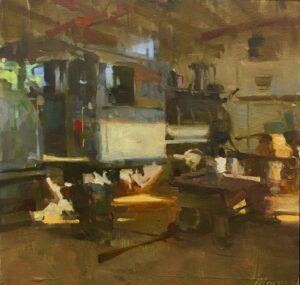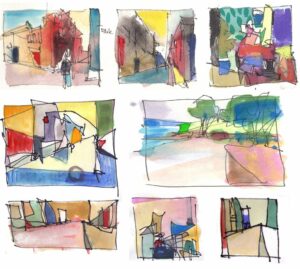I’ve heard it said by more than a few realist artists that they have no connection to abstract art. It’s not their thing, they don’t get it, it’s not real art, etc. Of course, everyone is entitled to their opinion, but I believe that some of these artists are missing out on addressing a key component of individuality in painting; trust. I teach abstract painting for this very reason.
The goal is not to convert realist painters into abstract ones but to help the artists think about what paint can do if you let it by employing dynamic symmetry, hierarchy, division of space, edge, paint handling and color relationships without basing it on a source. Painting abstractly has helped my realist work grow in leaps and bounds. And to date, after 25 plus years of teaching, no one has jumped ship from their existing path, they expand their visual language and take the lessons to fold back into their process.
To build trust in one’s own process is to enable the unique voice of the artist. This voice is comprised of some combination of the key characteristics of painting; intent, drawing, value, color, edge, paint handling, mark making, composition, line, narrative and about 10 other devices in the painter’s tool kit. It’s why there are so many wings at the Metropolitan Museum of Art. Lots of unique voices in art equal lots of wings in lots of museums. And who do we go to see when visiting such places? Those artists who exhibit that trust, that faith in their own vision, the pioneers, the masters of hand and medium. We seek those who are empowered by authenticity.
I mean, let’s face it, if everyone painted the exact same way, it’d be pretty dang boring.
Key to trust building is to venture out past the comfortable known areas of process and concept and hang out on the thin branches for a while. You’d think it would be easy for artists to do this, because what’s the worst that could happen? But, surprisingly, it’s not. The realist regimen incorporates a series of control measures to ensure a fair amount of accuracy: Get your drawing right, get your values right, put something on the thirds cross-hairs, mix the paints just so… all to beautiful effect. Control on the front end.
Abstract painting is that only backwards, the control is on the back end. Which means higher risk and higher failure rates and that can be uncomfortable. But the process of doing, even on a small scale, teaches an enormous amount about what paint can do independent of subject or content in a painting. As part of a healthy aesthetic training program, it’s sort of like taking a day to do Argentine Tango if you are more of a Viennese waltz kind of a person.
I could rattle off a ton of realist deities whose work dances with the abstract: N. Fechin, C. Anderson, J. Sorolla, C. Monet, J. Twachtman, E.C. Fortune, G. Klimt, E. Dickenson, T. H. Benton, T. Thompson, B. Dugarzhapov and so on. If you put realist painting on the same spectrum as abstract painting, some of these artists are just a little closer to one end than the other.
So, what’s to be gained from this kind of exploration?
• It gets you unstuck in a hurry.
• Enhances creative thinking skills.
• Enhances critical thinking skills.
• More paint handling ideas.
• A better understanding of what the components of painting can do.
• More adventurous compositional ideas.
• Your significant other will find you more attractive.
• You will loosen up just a little bit.
• Your back won’t hurt as much.
Don’t hold me to all of those but at least a few will happen.
Let’s say that you are at least moderately intrigued. What next? How does one do this kind of playful study? The doing it part is pretty easy, it’s the brain part that you have to deal with. There are several secrets to getting your brain to go along with the plan because we are creatures of habit and change is not always easy.
• Give yourself permission to play.
• Spend a few hours making shapes on canvas with a brush and one color. Make compositional shape ideas.
• Change your approach. Change your materials, your brushes, tape canvases into quarters to disable the perfectionist feature.
• Work out from a reference source (see ink and wash sketches), put the reference source away and paint from the sketches. Repeat.
• Mix up some large piles of color that you love and just start moving it around. Come back in an hour or two and work on refining the paint into interesting compositions.
• Hide them away for a while. Just be like Dr. Frankenstein and keep your creations in the cellar.
If you ever feel a little stuck or bored with yourself, this is as good a cure as I’ve found. And don’t worry, you won’t suddenly start wearing a rainbow wig or anything weird. But, trust me, you will learn something new about yourself. If you want to know more about really digging deeper, I can recommend a darn good book.
About Larry Moore
Artist, author, instructor, illustrator.
Larry has been a college and workshop instructor for nearly 30 years. From winning a Gold Medal at the Society of Illustrators in New York, to winning Best of Show in national plein air invitationals, inclusion in Society of Illustrators annuals, and Communication Arts design and illustration annuals, he’s employed and refined the essential creative process you’ll read about in his book on creative thinking, Fishing for Elephants. Insights and exercises to develop authentic creativity. Available on Amazon.com.
by Larry Moore
24″ x 24″ oil on wood
A little playful exploration in color building.
by Larry Moore
by Larry Moore
16″ x 16″ oil on wood
Painted on-site in Maui, Hi
by Larry Moore
A don’t-pick-your-pen-up drawing continuous line style that changes the way you draw and think. Color is added either from memory or randomly.
by Larry Moore
24″ x 20″ oil on wood
An old sugar mill, painted on site in Maui, Hi.
by Larry Moore
30″ x 40″ oil on wood
One of the very first in the Intrusion series. A wonderful playground for new ways to build paint and come at narrative ideas in different ways.






Leave a Reply